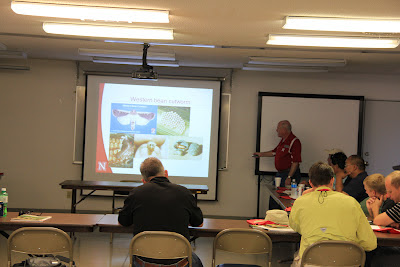Rachel Carson, 1907-1964
Silent Spring was one of the first books to address some of the negative effects pesticides can have on animals, including humans. She often argued for more "look before we leap" caution to synthetic pesticides. One of the first popular pesticides, DDT, was manufactured by the Swiss in 1939. DDT was used by many around the world, including the US Army to control malaria, typhus, and dengue fever during WWII.
DDT trucks were common to see on the streets in the 1950s. Sometimes kids would run after the trucks to get dusted.
To show how harmless DDT dust was to humans, advertisements like this were popular. Model Kay Heffernon with a soda and hot dog on Jones Beach, NY 1948. Photo by George Silk, LIFE photos.
DDT was popular for home use as well to kill nuisance pests.
At the same time of increasing popularity of synthetic pesticides, Rachel was noticing a decline in bird populations. She called pesticide overuse as a "silencing of the birds." In Silent Spring, she outlined how biomagnification concentrated chemicals through the food chain. Although she reviews many case studies in her book, her example of robin decline at Michigan State University was particularly interesting. In the mid 1950s, ornithologist George Wallace discovered dead and dying robins on campus; tests confirmed elevated levels of DDT. He later showed DDT used to control Dutch Elm Disease was takeng up by earthworms that were toxic food for many birds.
Another example of DDT biomagnification was in the Bald Eagle. By the early 1960s, only about 400 breeding pairs were in the lower 48 states. One suspected cause of decline was egg shell thinning and sterility from DDT. In 1967, Bald Eagles were placed on the Endangered Species List. The US banned DDT in 1972 and the number of breeding pairs has dramatically increased 20-fold. In 2007, the Bald Eagle and other bird species were removed from the Endangered Species List.
Her books and other publications got mixed reviews from scientists and industry. She testified before congress and called for a "pesticide commission" to help protect human health and the environment. Of the 12 pesticides she mentioned in her book, 8 are now banned and 3 are severely restricted. Rachel raised awareness for the environment and the need for regulation; and in 1970 the EPA was created. She revived many awards for her efforts, including the Presidential Medal of Freedom after her death. Although I do think pesticides have a place for pest control in order for food production and human health, I do agree with Rachel that we should them in more cautiously and with purpose. For more information about Rachel Carson, visit these links:






.jpg)












